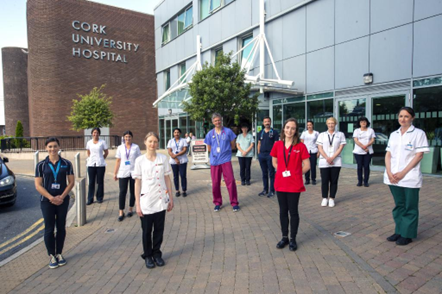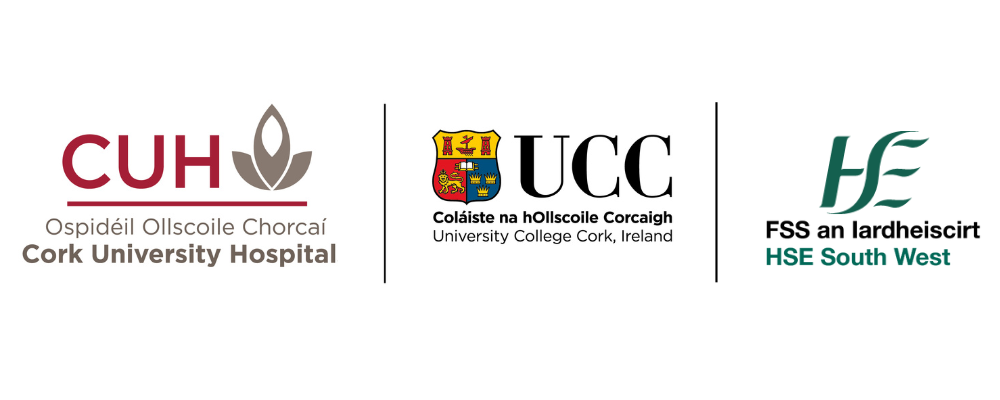Stroke
Welcome to the Speech and Language Therapy Stroke Team:
At Cork University Hospital (CUH), the Stroke service is made up of an interdisciplinary team, which includes specialist Consultants, Doctors, Nurses, Physiotherapists, Occupational Therapists, Speech and Language Therapists (SLT), Dietitians, Medical Social Workers and Psychologists, to name but a few. This dedicated team supports adults who have experienced a stroke and require specialist care.
Our Stroke Team

Image sourced here https://www.irishexaminer.com/cms_media/module_img/3888/1944092_1_org_1874519_1_org_image_19_.png
Information on this page is specifically about Stroke and the role of the Speech and Language Therapist in supporting adults who have had a stroke
Speech and Language Therapy
Speech and Language Therapists (SLT) are key members of the in-patient Stroke Unit and the Early Supported Discharge team. SLTs work together with the person who has had a stroke, their family, carers and other healthcare professionals, to support and overcome any challenges as a result of a stroke.
What does a speech and language therapist do to support someone who has had a stroke?
SLT’s can support people who experience communication and swallowing difficulties after a stroke. Some people may experience changes to their swallow and not their communication or the other way around, or both.
Changes might be mild or more severe and will vary from person to person. The level of support person needs will also vary.
The SLT can help with:
- Assessing, diagnosing and treating changes to communication and / or swallowing.
- Provide strategies and training to families and carers including tips and strategies to support their loved one at mealtimes and / or express themselves to communicate their wishes and needs.
SLT assessment, diagnosis and intervention will be individualised to each person depending on their strengths and goals.
What is Communication?
Communication is how we chat and interact with others. We communicate through speaking, finding the correct word, listening to and understanding what others are saying. We also communicate through reading and writing, such as texting, writing a letter, reading an email. When we communicate, we also use facial expression and tone of voice to express humour, sarcasm etc.
What sort of communication difficulties can people have after a stroke?
- Aphasia: difficulty with finding the correct word, understanding others, reading, writing. For more information click here.
- Dysarthria:difficulty speaking clearly, speech may low in volume, sound mumbled, slurred or monotone. For more information click here
- Apraxia:difficulty coordinating muscle movements to make sounds, words or sentences. For more information click here
- Cognitive communication difficulties: changes to our thinking skills which impact how we communicate. For more information click here
What is swallowing?
Swallowing is our ability to eat and drink. Swallowing is a complex skill which is controlled by the brain, nerves and muscles. Difficulty swallowing is called ‘dysphagia’.
What sort of swallowing difficulties can people have after a stroke?
As mentioned above, difficulties can range from mild to severe.
Mild difficulties may include difficulty chewing tough meat or toffee. More severe difficulties include food and drinks going into the lungs, instead of the stomach. This can lead to aspiration pneumonia. Early identification of swallowing difficulties post-stroke is very important to prevent secondary complications such as aspiration pneumonia which can impact a person’s ability to engage in rehabilitation.
Intervention:
After assessing and diagnosing communication and / or swallowing difficulties, the SLT will support the person to make goals to overcome these new challenges.
Examples of goals:
- Communication : “ I would like to be able to make a phone call to my friends” or “I’d like to say a speech at my daughter's wedding”
- Swallowing : “ I would like to eat dinner in a restaurant”
Together, with the SLT and other healthcare professionals, the person will be supported to work on these goals in therapy and in everyday tasks.
Intervention may include therapy sessions and learning new ways to communicate and / or eat and drink safely.
Sessions can be:
- 1:1 with the SLT
- 1:1 with the SLT assistant
- Independent practice and programmes on the unit or at home
- Group sessions with others
- Sessions in the community, such as the grocery shop, post office, coffee shop
Sessions may include exercises, work sheets and tasks to support communication and / or swallowing difficulty.
Learning new ways to overcome difficulties can include learning and practicing new techniques and strategies. For example:
- Communication strategy: use key words
- Swallowing strategy: take a drink after three mouthfuls of food
Family, friends and carers can also support the person by using specific tips and strategies, which the SLT will recommend. The SLT may also offer sessions to family members and carers.
